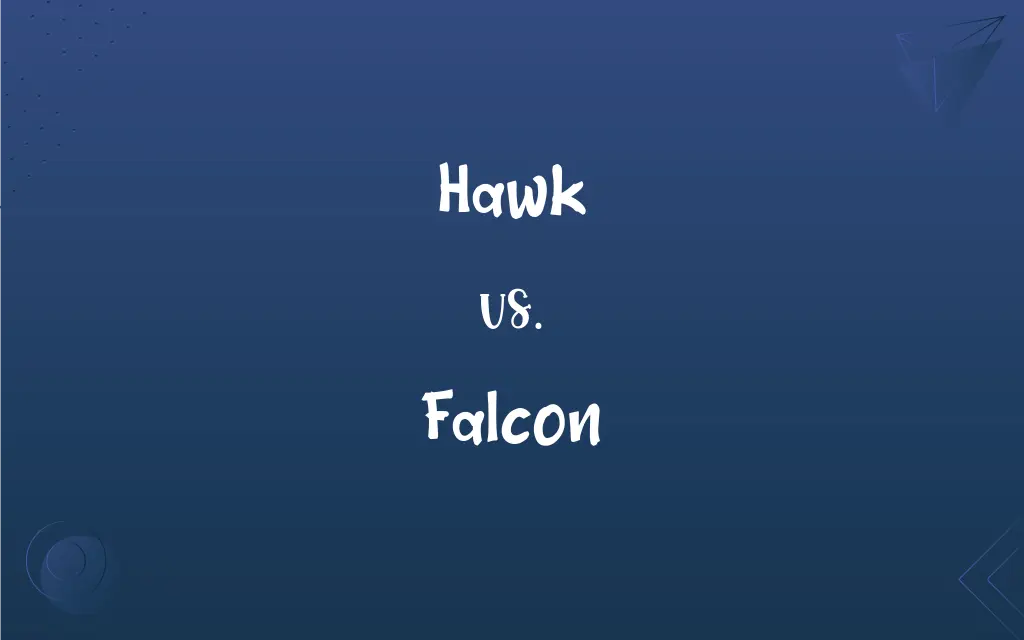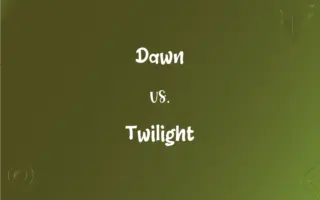Hawk vs. Falcon: What's the Difference?
Edited by Aimie Carlson || By Harlon Moss || Updated on May 31, 2024
Hawks are broad-winged raptors known for soaring, while falcons have pointed wings and excel in high-speed pursuits.

Key Differences
Hawks and falcons are both birds of prey, but they belong to different families and exhibit distinct behaviors and physical characteristics. Hawks, which are part of the Accipitridae family, tend to have broad wings and short tails. Their flight pattern is usually characterized by soaring in wide circles. Falcons, on the other hand, belong to the Falconidae family. They have slender, pointed wings and a long tail, making them agile fliers.
In terms of hunting tactics, hawks generally use stealth and surprise. They often perch in concealed locations, waiting to ambush their prey. Falcons, however, are more about the chase. Their high-speed pursuits are a sight to behold, with some species targeting birds in mid-air.
Physiologically, there's a notable difference in their beaks. Hawks have a simple curve to their beak, while falcons possess a "tooth" on the beak known as a tomial tooth. This feature helps falcons to sever the spinal cords of their prey.
Lastly, both hawks and falcons can be found all over the world, but their habitats can differ. While hawks can be seen in a variety of environments, including forests, meadows, and urban areas, falcons prefer more open spaces, allowing them to utilize their speed to the fullest.
Comparison Chart
Wing Shape
Broad wings
Pointed, slender wings
ADVERTISEMENT
Tail Length
Shorter tail
Longer tail
Hunting Strategy
Stealth and ambush
High-speed chase
Beak Feature
Simple curved beak
Beak with a tomial tooth
Preferred Habitat
Forests, meadows, urban areas
Open spaces
Hawk and Falcon Definitions
Hawk
Hawk generally hunts by ambush.
The hawk sat silently on a branch, waiting for a mouse to appear.
ADVERTISEMENT
Falcon
Falcon is a bird known for its speed and agility.
The falcon dove at an incredible speed, catching the pigeon mid-air.
Hawk
Hawk belongs to the Accipitridae family.
The red-tailed hawk is a common member of this family.
Falcon
Falcon possesses a distinctive tomial tooth on its beak.
The falcon's beak is specially designed to sever its prey's spinal cord.
Hawk
Hawk is a bird of prey with broad wings.
The hawk soared high in the sky, scanning for prey.
Falcon
Falcon typically hunts in high-speed pursuits.
The falcon's streamlined body allows it to maneuver swiftly in the air.
Hawk
Hawk often has a strong, curved beak.
The hawk used its beak to tear into its meal.
Falcon
Falcon thrives in open habitats.
In the open plains, the falcon's speed is unmatched.
Hawk
Hawk can have varying sizes and colors.
The hawk's sharp eyesight allows it to spot prey from great distances.
Falcon
Falcon is a member of the Falconidae family.
The peregrine falcon is a renowned species of this family.
Hawk
Any of various birds of prey, especially of the genera Accipiter and Buteo in the family Accipitridae, characteristically having a short hooked bill and strong claws used for seizing.
Falcon
Any of various birds of prey of the family Falconidae and especially of the genus Falco, having a short, curved beak and long, pointed, powerful wings adapted for swift flight.
Hawk
Any of various similar birds of prey.
Falcon
Any of several birds of these or related species, such as hawks, trained to hunt small game.
FAQs
What do hawks typically eat?
Hawks primarily eat small mammals, birds, and reptiles.
Are hawks found worldwide?
Yes, hawks can be found in various regions around the world.
How do hawks typically capture their prey?
Hawks usually ambush their prey from a concealed perch.
How many species of hawks are there?
There are over 200 species of hawks worldwide.
Do falcons mate for life?
Many falcon species form monogamous pairs that mate for life.
Are hawks and falcons the same?
No, hawks and falcons belong to different families and have distinct characteristics.
Are falcons used in falconry?
Yes, falcons are popular birds in the sport of falconry due to their speed and agility.
Why do falcons have a tomial tooth?
The tomial tooth helps falcons to sever the spinal cords of their prey.
Which bird has broader wings, a hawk or falcon?
Hawks typically have broader wings compared to falcons.
How do falcons typically hunt?
Falcons hunt using high-speed pursuits, often targeting birds in flight.
How can you distinguish between a hawk and falcon in flight?
Falcons have pointed wings and fly faster, while hawks have broader wings and often soar.
Which bird is faster, a hawk or a falcon?
Falcons, especially the peregrine falcon, are known to be faster than hawks.
Is the peregrine falcon the fastest bird?
The peregrine falcon is considered one of the fastest birds, especially during its dive.
What is the main diet of a falcon?
Falcons primarily feed on birds and sometimes small mammals.
Do hawks build nests in trees?
Yes, many hawk species build nests in trees, often high off the ground.
Do falcons have a special feature on their beak?
Yes, falcons have a "tooth" on their beak called a tomial tooth.
Which bird is more likely to be seen in a forest?
Hawks are more commonly found in forests than falcons.
What is the habitat preference of a falcon?
Falcons generally prefer open spaces for hunting.
Can hawks be seen in urban areas?
Yes, some hawk species have adapted to urban environments and can be seen in cities.
Do hawks have good eyesight?
Yes, hawks have exceptional eyesight, allowing them to spot prey from great distances.
About Author
Written by
Harlon MossHarlon is a seasoned quality moderator and accomplished content writer for Difference Wiki. An alumnus of the prestigious University of California, he earned his degree in Computer Science. Leveraging his academic background, Harlon brings a meticulous and informed perspective to his work, ensuring content accuracy and excellence.
Edited by
Aimie CarlsonAimie Carlson, holding a master's degree in English literature, is a fervent English language enthusiast. She lends her writing talents to Difference Wiki, a prominent website that specializes in comparisons, offering readers insightful analyses that both captivate and inform.































































